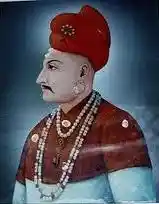When the Peshwas took over the Maratha clan
After Bajirao I, there was no denying the status and power of Peshwas in the huge empire of Marathas. However, they still held the second position in the power hierarchy. What if they were to take over the Maharaja himself?

Peshwa Balaji Bajirao also known as Nana Saheb; Image source: Wikipedia
Peshwas were the Prime ministers of the Maratha rulers. The Maharaja was governed by a council of 8 ministers of whom the Peshwa was the supreme power. The post of Peshwas was made hereditary Balaji Vishwanath and since then the Peshwa family has been the right hand of the King. But for how long can such a relationship last?
This is the story of how Peshwas took over their power status from being the second centre of authority to being the supreme power, condemning the Chatrapati to a mere title with no power.
Balaji Baji Rao, who was also known as Nana Saheb was the son of Bajirao the first. The father and son didn't have the best relationship. Bajirao I was the fighting Peshwa and most of the time was out on military campaigns. Also, it was kind of a custom that the Peshwa took their sons to battlefields like how Balaji Vishwanath took Bajirao I to battlegrounds when he was barely 10, in order to get him accustomed to the war scenarios. However, Nana Saheb did all this with his father’s younger brother, Chimaji Balaji.
There was a more concrete reason for the dislike for his father. Nana Saheb disliked his father’s affair with Mastani. After the untimely death of his father, Sahu appointed Nana Saheb from Pune to Satara as the Peshwa.
His father had established control over the lands of Malwa and Bundelkhand however, the formal recognition of Marathas as the overlords of the place was only done by Nana Saheb. He also won over the lands of Bihar, Bengal and Orissa. However, they only raided and looted these lands and never established a firm control or any administrative set up there.
Bajirao had already won over the vast expanse of lands but Nana Saheb took upon himself to expand the work although in many ways his military campaigns were different. Unlike his father, he didn't manage to have good relations with Rajputs.
When Chatrapati Sahu died, the game of thrones began. Sahu died without an heir and the discussion as to who should be the next ruler was in process. In the ending days of Sahu, Tarabai, the person whom he had to fight to get the throne again came into the picture. She had presented a child (Rajaram) in front of him and said he was her grandson. If the child was her grandson that would have meant he was a direct descendant of Shivaji which is why it is said that Sahu accepted the child.
After Sahu’s death, Tarabai tried to make Rajaram, the Chhatrapati. Nana Saheb didn't approve of this idea. He along with the council of ministers knew the child was not truly of Shivaji’s descent and was a way of Tarabai trying to become the regent ruler. However, Rajaram managed to become the Chhatrapati.
We know from past experience that Peshwas held immense power and it would have been impossible for him to be the king if Peshwa didn't allow it. Why did Nana Saheb allow it?
It was probably because Nana Saheb knew the post of Maharaja was no longer what it used to be and he was sure that he could overpower it. This is exactly what happened. When Tarabai tried to make Rajaram remove the Peshwa from authority and Rajaram refused, Tarabai declared that he was an imposter and she was lying about him being of Shivaji’s descent. She imprisoned Rajaram where his health deteriorated significantly.
With the truth out in the open, Peshwa’s and Tarabai’s forces were in head-on conflict. People in court picked sides, most of them siding with Peshwa. Tarabai became aware of the fact aware that she won’t be able to defeat the Peshwa. She unwillingly accepted defeat and acknowledged his superiority.
The Peshwa treated her with great respect and the two of them signed a peace treaty. Peshwa freed Rajaram from prison and allowed him to be the king even though he was not Shivaji’s bloodline. Instead, he signed a Sangola agreement which reduced the Chhatrapati to the status of a figurehead and transferred all the real power to the Peshwas.
The capital of Satara which was the main city of the Maratha Maharaja was no longer what it used to be. Now, Pune, the palace of Peshwas emerged as the capital city of Marathas.


